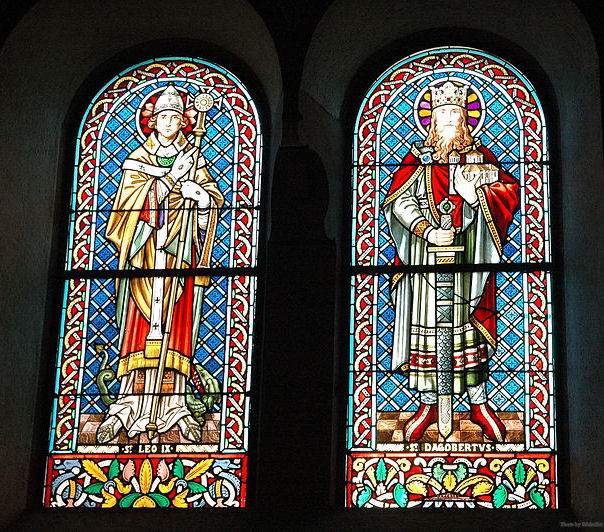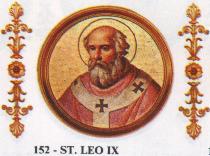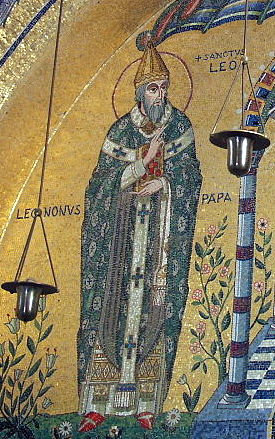Pope St. Leo IX
Pope St. Leo IX earnestly spread the Cluny reform
Born at Egisheim, near Colmar, on the borders of Alsace, 21 June, 1002, Pope St. Leo IX died on 19 April, 1054. He belonged to a noble family which had given or was to give saints to the Church and rulers to the Empire. He was named Bruno. His father Hugh was first cousin to Emperor Conrad, and both Hugh and his wife Heilewide were remarkable for their piety and learning.
When five years of age, he was committed to the care of the energetic Berthold, Bishop of Toul, who had a school for the sons of the nobility. Intelligent, graceful in body, and gracious in disposition, Bruno was a favorite with his schoolfellows. Whilst still a youth and at home for his holidays, he was attacked when asleep by some animal, and so much injured that for some time he lay between life and death. In that condition he saw, as he used afterwards to tell his friends, a vision of St. Benedict, who cured him by touching his wounds with a cross. This we are told by Leo’s principal biographer, Wibert, who was his intimate friend when the saint was Bishop of Toul.
Bruno became a canon of St. Stephen’s at Toul (1017), and though still quite young exerted a soothing influence on Herimann, the choleric successor of Bishop Berthold. When, in 1024, Conrad, Bruno’s cousin, succeeded the Emperor Henry I, the saint’s relatives sent him to the new king’s court “to serve in his chapel”. His virtue soon made itself felt, and his companions, to distinguish him from others who bore the same name, always spoke of him as “the good Bruno”.
Castle of the Counts of Eguisheim - birthplace of Pope St. Leo IX
In 1026 Conrad set out for Italy to make his authority respected in that portion of his dominions, and as Herimann, Bishop of Toul, was too old to lead his contingent into the peninsula, he entrusted the command of it to Bruno, then a deacon. There is reason to believe that this novel occupation was not altogether uncongenial to him, for soldiers seem always to have had an attraction for him.
While he was thus in the midst of arms, Bishop Herimann died and Bruno was at once elected to succeed him. Conrad, who destined him for higher things, was loath to allow him to accept that insignificant see. But Bruno, who was wholly disinclined for the higher things, and wished to live in as much obscurity as possible, induced his sovereign to permit him to take the see. Consecrated in 1027, Bruno administered the Diocese of Toul for over twenty years, in a season of stress and trouble of all kinds.
He had to contend not merely with famine, but also with war, to which as a frontier town Toul was much exposed. Bruno, however, was equal to his position. He knew how to make peace, and, if necessary, to wield the sword in self-defense.
Great Battle, by Grizzli
Sent by Conrad to Robert the Pious, he established so firm a peace between France and the empire that it was not again broken even during the reigns of the sons of both Conrad and Robert. On the other hand, he held his episcopal city against Eudes, Count of Blois, a rebel against Conrad, and “by his wisdom and exertions” added Burgundy to the empire. It was whilst he was bishop that he was saddened by the death not merely of his father and mother, but also of two of his brothers. Amid his trials Bruno found some consolation in music, in which he proved himself very efficient.
The German Pope Damasus II died in 1048, and the Romans sent to ask Henry III, Conrad’s successor, to let them have as the new pope either Halinard, Archbishop of Lyons, or Bruno. Both of them were favorably known to the Romans by what they had seen of them when they came to Rome on pilgrimage. Henry at once fixed upon Bruno, who did all he could to avoid the honor which his sovereign wished to impose upon him. When at length he was overcome by the combined importunities of the emperor, the Germans, and the Romans, he agreed to go to Rome, and to accept the papacy if freely elected thereto by the Roman people. He wished, at least, to rescue the See of Peter from its servitude to the German emperors.
When, in company with Hildebrand he reached Rome, and presented himself to its people clad in pilgrim’s guise and barefooted, but still tall, and fair to look upon, they cried out with one voice that him and no other would they have as pope. Assuming the name of Leo, he was solemnly enthroned 12 February, 1049. Before Leo could do anything in the matter of the reform of the Church on which his heart was set, he had first to put down another attempt on the part of the ex-Pope Benedict IX to seize the papal throne. He had then to attend to money matters, as the papal finances were in a deplorable condition. To better them he put them in the hands of Hildebrand, a man capable of improving anything. 
Pope St. Leo IX then began the work of reform which was to give the next hundred years a character of their own.
He then began the work of reform which was to give the next hundred years a character of their own, and which his great successor Gregory VII was to carry so far forward. In April, 1049, he held a synod at which he condemned the two notorious evils of the day, simony and clerical incontinence. Then he commenced those journeys throughout Europe in the cause of a reformation of manners which gave him a pre- eminent right to be styled Peregrinus Apostolicus. Leaving Rome in May, he held a council of reform at Pavia, and pushed on through Germany to Cologne, where he joined the Emperor Henry III. In union with him he brought about peace in Lorraine by excommunicating the rebel Godfrey the Bearded.
Despite the jealous efforts of King Henry I to prevent him from coming to France, Leo next proceeded to Reims, where he held an important synod, at which both bishops and abbots from England assisted. There also assembled in the city to see the famous pope an enormous number of enthusiastic people, “Spaniards, Bretons, Franks, Irish, and English”. Besides excommunicating the Archbishop of Compostela (because he had ventured to assume the title of Apostolicus, reserved to the pope alone), and forbidding marriage between William (afterwards called the Conqueror) and Matilda of Flanders, the assembly issued many decrees of reform. On his way back to Rome Leo held another synod at Mainz, everywhere rousing public opinion against the great evils of the time as he went along, and everywhere being received with unbounded enthusiasm.
In January, 1050, Leo returned to Rome, only to leave it again almost immediately for Southern Italy, whither the sufferings of its people called him. They were being heavily oppressed by the Normans. To the expostulations of Leo the wily Normans replied with promises, and when the pope, after holding a council at Spoleto, returned to Rome, they continued their oppressions as before.
At the usual paschal synod which Leo was in the habit of holding at Rome, the heresy of Berengarius of Tours was condemned-a condemnation repeated by the pope a few months later at Vercelli. Before the year 1050 had come to a close, Leo had begun his second transalpine journey. He went first to Toul, in order solemnly to translate the relics of Gerard, bishop of that city, whom he had just canonized, and then to Germany to interview the Emperor Henry the Black. One of the results of this meeting was that Hunfrid, Archbishop of Ravenna, was compelled by the emperor to cease acting as though he were the independent ruler of Ravenna and its district, and to submit to the pope.
Returning to Rome, Leo held another of his paschal synods in April, 1051, and in July went to take possession of Benevento. Harassed by their enemies, the Beneventans concluded that their only hope of peace was to submit themselves to the authority of the pope. This they did, and received Leo into their city with the greatest honor. While in this vicinity, Leo again made further efforts to lessen the excesses of the Normans, but they were crippled by the native Lombards, who with as much folly as wickedness massacred a number of the Normans in Apulia. Realizing that nothing could then be done with the irate Norman survivors, Leo retraced his steps to Rome (1051).
Pope Leo raised what forces he could among the Italian princes and declared war on the Normans
The Norman question was henceforth ever present to the pope’s mind. Constantly oppressed by the Normans, the people of Southern Italy ceased not to implore the pope to come and help them. The Greeks, fearful of being expelled from the peninsula altogether, begged Leo to co-operate with them against the common foe. Thus urged, Leo sought assistance on all sides. Failing to obtain it, he again tried the effect of personal mediation (1052). But again failure attended his efforts. He began to be convinced that appeal would have to be made to the sword. At this juncture an embassy arrived from the Hungarians, entreating him to come and make peace between them and the emperor. Again Leo crossed the Alps, but, thinking he was sure of success, Henry would not accept the terms proposed by the pope, with the result that his expedition against the Hungarians proved a failure. And though he at first undertook to let Leo have a German force to act against the Normans, he afterwards withdrew his promise, and the pope had to return to Italy with only a few German troops raised by his relatives (1053). In March, 1053, Leo was back in Rome. Finding the state of affairs in Southern Italy worse than ever, he raised what forces he could among the Italian princes, and, declaring war on the Normans, tried to effect a junction with the Greek general. But the Normans defeated first the Greeks and then the pope at Civitella (June, 1053). After the battle Leo gave himself up to his conquerors, who treated him with the utmost respect and consideration, and professed themselves his soldiers.
Though he gained more by defeat than he could have gained by victory, Leo betook himself to Benevento, a broken-hearted man. After the battle of Civitella Leo never recovered his spirits. Seized at length with a mortal illness, he caused himself to be carried to Rome (March, 1054), where he died a most edifying death. He was buried in St. Peter’s, was a worker of miracles both in life and in death, and found a place in the Roman Martyrology.
WIBERT and other contemporary biographers of the saint in WATTERICH, Pont. Rom. Vitæ, I (Leipzig, 1862); P. L., CXLIII, etc.; ANSELM OF REIMS, ibid., CXLII; LIBUIN in WATTERICH and in P. L., CXLIII; see also BONIZO OF SUTRI; ST. PETER DAMIAN, LANFRANC, and other contemporaries of the saint. His letters are to be found in P. L., CXLIII; cf. DELARC, Un pape Alsacien (Paris, 1876); BRUCKER, l’Alsace et l’é au temps du pape S. Léon (Paris, 1889); MARTIN, S. Léon IX (Paris, 1904); BRÉHIER, Le Schisme Oriental au XIe Siecle (Paris, 1899); FORTESCUE, The Orthodox Eastern Church (London, 1907), v; MANN, Lives of the Popes, VI (London, 1910).
HORACE K. MANN (Catholic Encyclopedia)





No comments:
Post a Comment